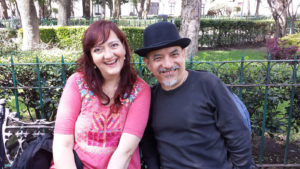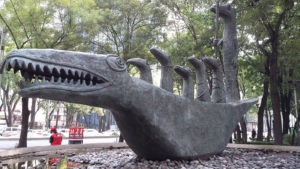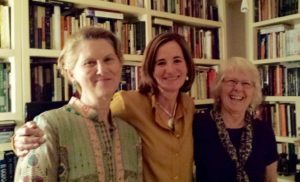Roxanna Erdman drives in this crazy city and does it well. She lives nearby and when Agustín Cadena gets to town, she brings him to our hotel—Agustín wearing a bowler hat. We are writers so our gifts amount to book swaps. I give them mine and get Agustín’s latest, Dibujos a lápiz, which I’m translating as Pencil Sketches; Roxanna gives me her charming bestiary, Zorrillo el último. I wonder about translating bestiaries, which are usually alphabetical. Since he’s a skunk, the zorrillo cannot be last in English.
Sunday morning traffic is light. Roxanna gets us to San Angel in no time, where we see the memorial plaque for the San Patricios, the Irish who fought for Mexico in the Mexican-American War. Agustín shows us where they raised the gallows. Half a block away, Roxanna calls our attention to galletas de iglesia, being toasted outside the church on a griddle. Church biscuits: a heavenly aroma.
To reach Catherine Mayo’s house, Roxanna noses through a maze of narrow lanes designed for donkey carts. Catherine’s referrals have been golden: she put me in touch with everyone I’m translating now. Catherine is American, has lived in Mexico for decades and writes in English. It took Agustín just six months to translate her novel about Maximilian. I can’t imagine how he did that: Mílada Bazant’s biography took me nine.
Catherine and I have both translated Agustín’s stories. “We have enough for a book,” she says. “Let’s work on that.” Collaboration is common amongst translators, and Catherine is as collaborative as they come. She’s a fan of digital publishing, but still thinks print essential. Brandishing the 2007 chapbook with her translation of Agustin’s story Carne Verde, Piel Negra/An Avocado from Michoacán, she exclaims, “It looks brand-new! It won’t disappear. Things you publish online disappear.”
The mangos she serves us for dessert, drizzled with lime, are perfect. Tasting mine, I feel as if I’m floating. “Yes,” she acknowledges, “it is their moment.” Our lunch conversation is lively, we stay longer than planned and reach the Frida Kahlo Museum an hour before it closes, the line to get in still impossibly long. It was like that when I tried in 2002. “That is the same line,” I declare.
Agustín has breakfast with us the next morning, asks for hot water, brings his own Earl Grey tea bag. On Reforma we visit a Leonora Carrington sculpture he wants us to see. He points across the wide boulevard: “That heavily fortified building is the American embassy.” It stands behind a tall blue metal fence, thick hedges, concrete barriers. He grins. “They don’t even fly the flag.”
We walk the Zona Rosa, stop at El Péndulo, a café-bookstore. Phil said later, “I could have stayed for hours. They have an English section. And good coffee.” I bought Ignacio Padilla’s book on the 1985 earthquake there because Mónica Lavín mentioned it in regard to her in-progress novel about the earthquake.
The next evening, Mónica had put her ipod on shuffle and as we arrive vintage Bob Dylan is playing. It ain’t me, babe. Phil and I are immediately drawn to the books, and Mónica gives us a swift tour of her library: American authors here, Latin American there, Mexicans elsewhere, two shelves of her own books. “It’s a little egotistical,” she apologizes. “I’m moving them to my studio.” “Well, before you do, I need a photo,” I say.
Jorge Prior arrives, and talk turns to documentaries. Jorge is working on a film about the late 19th century group of artists and writers who admired Manual Acuna, an early modernist poet. “I believe Manual Acuna is the person Laura Méndez de Cuenca had an affair with,” I exclaim. (I translated that biography: you’d think I could remember.) Mónica grabs her phone: yes, that’s right, and the out of wedlock baby is there too. I hope Jorge shows those artists digging up Acuna’s body years later. It’s a deliciously macabre event.
Catherine arrives with the evening rain and a blustery wind. Mónica closes the sliding glass balcony doors, serves a delicious huachinango as her ipod plays Johnny Cash. Later, the rain slackens and when she opens the doors again, fragrant cool air wafts over us.
Mónica and I discuss our proposed collection of stories, and mutter darkly about glacial editor response. I talk about the story I’m currently translating, in which Raymond Carver is mentioned. Where I’m Calling From is on her shelves. The mention is homage, but with its subtle, solitary epiphany, the story itself is a Carver story, I say. She had not thought of that. Creativity is sometimes mysterious, giving the author an intuition that her character would have read Carver. The writer writes, and is not always aware of all she does.
The days spin by and we find ourselves back in America and not braced for it. It is too loud, the RNC has ended and the DNC is in mid-stride. In the Houston airport, half-listening to Bloomberg speak, wearily waiting to start the last leg of our journey, I get a text from Agustín: “I am full of happy memories. You and Phil are encantadores.”





I miss you already!
We miss you! Not enough time.
It was a joy to see you all! Thanks for posting. I miss you guys!
And looking forward to seeing you at ALTA!